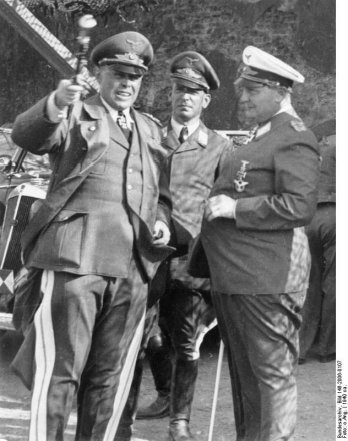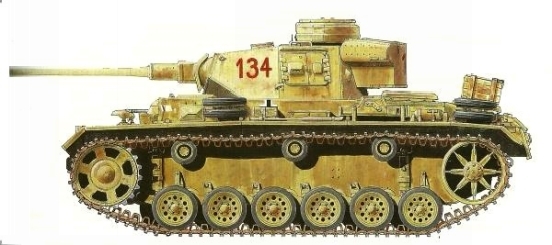Rommel's plan was rejected out of hand by Hitler and Mussolini who ordered that the Schott line be held to the last. In the Fuhrer's eyes Tunisia had to be held at all costs for the Axis presence tied up Allied men and shipping which might be used elsewhere. Secondly, Tunisia commanded the Sicilian narrows and for as long as Tunisia held, the Allies could not use it as a springboard from which to invade the mainland of Europe.

Rommel then drew Hitler's attention to the situation regarding fuel, ammunition, and reinforcements and commented on how the supply situation had deteriorated. The Royal Navy dominated the sea routes and no ships had arrived in North African ports. Only individual German military ferries could now reach Africa and the amounts they brought in were insignificant. Crippling losses - 80 per cent was an accepted figure - to the sky trains of Junkers 52 transport machines had all but stopped supplies arriving by air. In short the situation was disastrous.
The losses in transport aircraft were unbelievably high and every unit could report numbers of men who had been killed in transit. Elements of the 999th Division were in one sky train from which 18 aircraft carrying men of the division were shot down in flames over the Mediterranean and, indeed, the divisional commander who had set off from Sicily with most of his staff perished en route to Tunisia.
Hitler, for reasons which he never made public, did not allow Rommel to return to Africa so that the Army Group passed under the command of von Arnim who began to prepare it for the final battles.
Mareth Line
The British barrage which opened Montgomery's offensive at Mareth poured a flood of high explosives upon the Axis lines and in the fierce infantry fighting which followed the Young Fascist Division was driven from its position within a matter of hours. Determined to regain the lost ground the Italian troops went in at dawn with the bayonet and recaptured the heights. But this British assault was only a holding attack and from the area of Fort Tata-houine, to the south-west of the line, poured the forces for the main thrust. Farther to the north Patton's armoured division was thrusting towards the Gabes Gap. The under-gunned and under-manned units of the Axis desert army were under assault from the south, the south-west, and the west.
Despite this inferiority in everything but courage, the German and Italian infantry held out through the heaviest and longest bombardments which they had ever endured, backed by waves of Allied bombers who, arrogantly confident of superiority in the air, flew in rigid and close formation to cascade their bomb loads upon the front line troops and the rear areas alike. Not only did the Axis soldiers hold out - in some sectors they rose out of their positions to counter-attack and to recover the ground which they had had to void. [26]

By 23 March, Montgomery had failed in his attempt to force a decision on the south-western front and regrouping his forces, thrust them in a long arc to outflank the Axis positions by driving in a north and then north-westerly direction south of Djebel Tebaga in the direction of El Hamma. In this sector 90th Light Division held the ground and took the full force of the violent British assault. German units were rolled over as 2nd Armoured Brigade struck deep into the German line. The 90th Light swung back, regrouped, and counter-attacked but the end result could not be gainsaid. Montgomery's left hook had torn open the German flank and withdrawal to the Schott position was the only solution. Then came the deadly thrust by the New Zealanders, whose night attack strode across pak-fronts and artillery belts into the area behind 90th Light, and threatened to drive to the sea. But then the advance was halted and before it could roll forward again von Liebenstein, the commander of Africa Corps, had formed an assault group and put it into action against 8th Army. A pincer operation by both panzer divisions then drove into the New Zealand flank and brought the British advance to a halt while the remainder of Africa Corps took up its positions along the Schott Line.
The end of March saw the beginning of the tightening of the noose around the Axis forces in Tunisia. From the probing attacks on the western and south-western sectors of the front the emphasis then fell upon the southern flank where 8th Army, having regrouped after the Mareth battles, was shepherding the desert veterans of 1st German/Italian Panzer Army into a killing ground towards a situation which would end the campaign.
The position which the Germans called the Schott line blocked the 18-mile gap between the Schott el Fedjadj and the sea. The battle which was foughi along this line is known to British military historians as the battle of Wadi Akarit. The Schott line ran from south of Djebel Heidoudi, via Djebel Tebaga Fatnassa and Djebel Roumana along the Wadi Akarit to the Mediterranean. The coastal plain north-west of Gabes is only five miles wide at its narrowest point and across the greatest part of this is the steep-sided, deep, anti-tank obstacle of the Wadi Akarit. The mountains of the Schott el Fadjadj were impassable to tanks coming from the west and the only danger lay on the western flank behind the Schott line for, from the direction of El Geuttar and Maknassy, strong United States tank forces might drive and overwhelm the 10th Panzer Division which held the position near those places.
The battles at Mareth had weakened the Axis forces and quoting the War Diary of 164th Division, it was calculated that at El Hamma manpower losses had amounted to 1100 men. The rifle strength of 164th Division was down to the equivalent of three understrength battalions although two companies from a replacement battalion belonging to 15th Panzer Division came on strength from 30 March. The usual divisional components were equally weak and the artillery support was still only a single battery. Acutely aware of the impotence of his forces and the even more serious inability of the Italians to defend their positions, Rommel deployed his forces so that the Germans held the sensitive areas. Italian XX Corps, with 90th Light under command, guarded the coast road while 164th Division under XXI corps, took up position on that Corps' right flank around and east of Djebel Heidoudi. The mountain positions were all held by Italian troops and to maintain contact with Panzer Army Africa's main body and von Broich's 10th Panzer Division battle group, the Sahara Group carried out wide-ranging and frequent patrolling. There were several major movements of armour as a result of which 21st Panzer Division was posted to 5th Panzer Army, leaving 15th Panzer Division in Army reserve and positioned behind Army's left wing.
The whole Axis front lay waiting throughout the long nights of the last week of March for 8th Army's new blow to fall and in anticipation of this the outpost line in position on a low ridge three miles in front of the main body was withdrawn. The first British attack came in on the night of 3/4 April and positions were lost by Trieste Division. A counter-attack by 90th Light won these back but these were only probing attacks by the British whose main assault came in at dawn on 6 April, behind a heavy artillery barrage. At Djebel Tebaga a silent night attack by Gurkha troops and carried out before zero hour had captured the crest of the mountain before the main attack went in. By lO.OOhrs on 6 April the front held by both Trieste and Spezia Divisions had been breached and Djebel Roumana and Djebel Tebaga Fatnassa had both been lost. The 164th Division, minus the battalion from 15th Panzer, was then moved to a point behind the front centre of the line to act as Army reserve and, as the division was moving, the order came for the non-motorised units to begin their withdrawal to the Enfidaville position while the German Panzer units held the line. The Schott line could not be held and the Axis armies were moving back to new defensive positions.